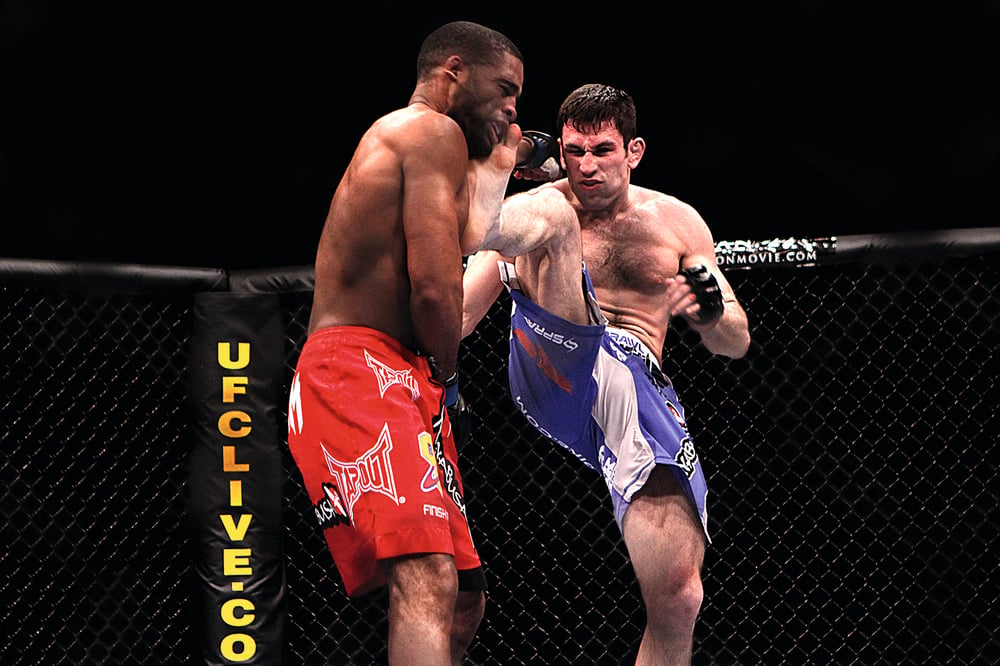
Issue 061
April 2010
Forrest Griffin used to have the monopoly on being the only goofy, self-deprecating reality TV show-winning MMA fighter. That was until Amir Sadollah came along.
A 29-year-old former surgical tech, the Brooklyn-born Virginia native stunned fans by becoming the first fighter with no professional experience to win The Ultimate Fighter. Since winning his six-fight contract in 2008, Sadollah quickly earned a reputation as one of the unluckiest fighters in MMA, following a hospitalization for a staph infection and later suffering a broken clavicle.
Two solid wins in short turnaround have righted Sadollah’s course and his fortunes seem to be improving, opening the door for the fighter to work his way through the ranks of the welterweight division.
“Looking back, I’m always a bit of a perfectionist; I always want to be better and better,” says Amir Sadollah after training. He’s just spent a series of rounds attacking the leather pads and bags, at the Warrior Training Center, with a variety of Muay Thai strikes, and he’s referring to his recent fights with Phil Baroni (November 21, 2009) and Brad Blackburn (January 11, 2010).
Sadollah spent six rounds in the Octagon with two of the welterweight division’s most powerful strikers, yet he came out on top in both cases. He didn’t just win, but looked good in the process, drawing praise from all quarters for his clinical Muay Thai style and use of traditional attacks. “It was great, I was happy,” he says offhand.
Amir Sadollah is not the kind of guy to ring his own bell, unless you catch him at the right moment. Sadollah shares a similar sense of humor with Forrest Griffin; slightly bizarre, goofy and self-deprecating, though he’s less acidic than the self-confessed ‘jerk’ Griffin.
Intelligent, articulate and well spoken, Sadollah is an educated man. A former surgical technologist, he graduated with a degree from the J Sargeant Reynolds Community College in Richmond, Virginia, and worked in operating theaters alongside surgeons. Unlike many fighters, Sadollah was not a jock in school and did not come from an athletic background. He started training in mixed martial arts as a way to stay in shape, and only took his first amateur fight after a full year of training.

Sadollah’s big break came when he applied for TUF 7, which featured middleweight fighters. Though he had no professional fights, he was selected to be one of the 16 fighters who could compete for a place in the house. Sadollah walked through the field, stopping every single one of his opponents (including Gerald Harris, Matt Brown and CB Dolloway) en route to winning the series and the coveted six-fight contract. It seems amazing that someone could walk through TUF with seemingly no experience and go on to make his pro debut in the Octagon, but that wasn’t quite the case.
“I wasn’t inexperienced,” says Sadollah, referring to his time on the show. “I’d had five amateur Muay Thai fights, and five amateur MMA fights and grappling experience. I’d done pretty well; I was undefeated as an amateur. MMA was something I wanted to break into but early on I had good coaches who realized that you couldn’t be a one-trick pony. I tried to stay balanced by doing the Muay Thai and grappling as well. Skill-wise, I thought I could compete, but on paper, sure, it was a bit of an uphill battle.”
Though clearly the most talented fighter in the house, Sadollah was not seen as a ringer by his fellow competitors, even if he was the only one without any pro fights on his record. “Everyone respected each other – we all fought to get in; we all earned the opportunity. The respect level in the house was high.”
Sadollah’s glory after winning TUF was short-lived. A string of bad luck followed: His UFC debut proper was postponed when he was hospitalized with a severe staph infection, a bug that has dropped more Vegas fighters than a takedown from Randy Couture. Later, a broken clavicle put him out of another proposed matchup. It was over a year before Sadollah could return and compete in the Octagon.
“It’s not the way anyone wants to start a career. Looking back, the best I can pull from it is: Everything happens for a reason,” he says with a shrug. “Any hardship you can overcome is good for you, and there was a lot of hardship. It made me strong. I’m just glad I still do what I do and I’m at the level I’m at.”
The absence from the Octagon gave him opportunity to work on areas that required his attention. In the shark-tank world of MMA, constant improvement is necessary for survival, and one of Sadollah’s main ways of staying sharp is to travel to Holland to train Muay Thai. “I’ve been going back and fore to Holland even before I was on TUF. I really like their style of striking and their approach to Muay Thai. I thought theirs was a step above everyone else’s. I think I’ve taken a lot from it.”

The effect of training in Holland was evident in Sadollah’s last two appearances in the Octagon, which came in extremely short succession. He went from fighting Baroni in November to Blackburn in January, a turnaround of only seven weeks, hardly enough time to allow the bruises to fade before stepping back in the cage. Facing two dangerous strikers back-to-back, you have to wonder whether he had done something to piss off Joe Silva, but Sadollah insists he was happy to fight. “I was really happy they asked me to fight again so soon, [the Blackburn fight] was in Virginia, which is my home state, so that’s really cool to be included, and lucky I got through the Baroni fight with no injuries. I talked to my coaches and they agreed it was a good thing, and I think it’s good to stay busy and to stay active. I had that long layoff. I tried taking a year off, now I’m going to stay a little busier, see how that works out.”
In dealing with Baroni and Blackburn, two notoriously hard hitters, Sadollah helped erase the memory of his shock 29-second TKO loss to wrestler Johny Hendricks. Caught cold, Sadollah went down and the fight was called in what was a controversial stoppage. Since then, his striking displays have shown that fight to be something of a fluke – although that’s not to say he hasn’t learned from it. “Every time you fight you’re learning on the job, and every time you fight you had better get better, because the competition only gets better.”
Sadollah is one of a handful of fighters who have a regular gig away from the Octagon, which doesn’t involve running a gym or a start-up clothing company. He works as an occasional presenter on Spike TV, hosting chat segments after episodes of TUF. The job came about during his absence from the ring, though he insists it wasn’t simply to keep him busy while he wasn’t fighting. “They noticed that in my absence the female viewership was going down and they had to do something,” he laughs.

Amir is not the kind of guy who lives in the limelight. A laid-back everyman, he admits that his semi-celebrity status as a fighter has been difficult to deal with. “To tell you the truth, I felt guilty about it. It took me a while to accept all the notoriety and for me not to feel uncomfortable that someone recognized me or thought they knew me, or thought they liked me just because of a TV show. It took a while for it to soak in. I felt bad about it, like I’d done something wrong. I dunno, it was weird – there was an adjustment period for sure,” he says.
Fighters such as Frank Mir and Kenny Florian have carved out places in the world of broadcasting, and though Sadollah definitely thinks there could be a future with the TV thing, for now he doesn’t want to take anything away from his first love – fighting. “When I say I feel bad about accepting some of the spotlight, that’s part of it,” he says. “This is coming from a guy who felt bad when he started playing golf, because I felt bad about cheating on my sport. It’s something down the line I would like to do, but right now I don’t want to divert any energy from the fighting. The only reason I got on TV was because of fighting. That’s what I owe it to and that’s what I want to continue to do until I’m not able.”
Sadollah insists his status as an up-and-coming welterweight, along with his past success in winning TUF and his continued TV work, haven’t changed him. On a scale of one to ten, we wanted to know how humble Amir really is. “I’m a million!” he laughs. “I’m the most humble motherfucker you’ve ever met!”
Written by Hywel Teague, with contributions from Gary Alexander.
...









